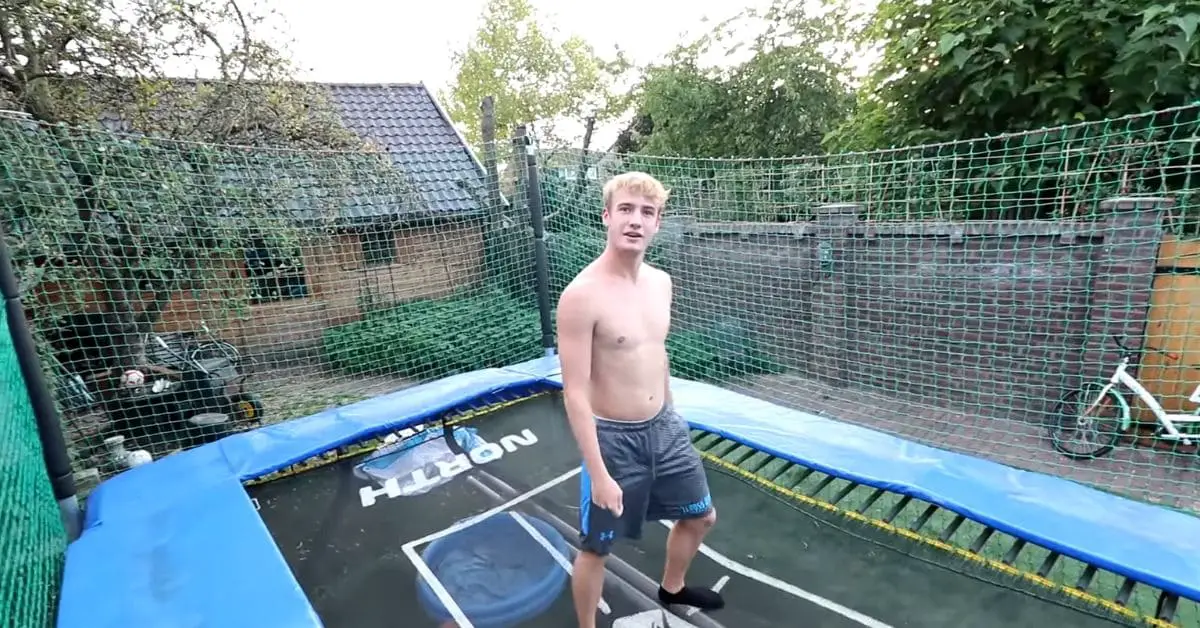Trampolines are a fun and exciting way to stay active and enjoy the outdoors. However, nothing is more disappointing than hopping onto your trampoline only to find that it’s lost its bounce. There are various reasons why a trampoline may not be as bouncy as it once was, ranging from wear and tear on the springs and mat to damage on the frame or jumping surface.
In this guide, we’ll explore the most common causes of a trampoline feeling less bouncy, how to diagnose the issue, and the steps you can take to fix the problem. We’ll also provide tips for maintaining trampoline bounce and important safety considerations to remember.
Whether you’re a seasoned trampolinist or a newbie, this guide will help you get the most out of your trampoline and ensure a safe and enjoyable experience.
Why is my trampoline not bouncy: A trampoline losing its bounce can be frustrating, but several common causes exist. From worn or damaged springs to a poor-quality mat, understanding the reasons behind a trampoline’s lack of bounce is critical to fixing the problem and getting back to enjoying your outdoor fun.
Why is my trampoline not bouncy?
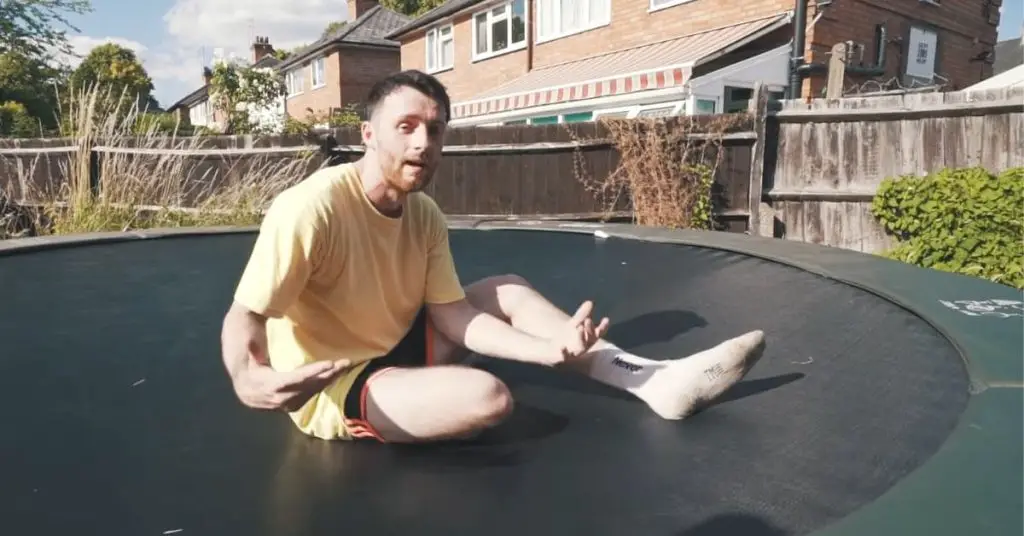
Trampolines are a popular outdoor activity for people of all ages, providing hours of entertainment and a great way to exercise. However, trampolines can lose their bounce over time, making it difficult to enjoy them fully.
We’ll explore why a trampoline may not be bouncy and how to address these issues.
Lack of tension in springs or frame
One of the most common reasons why a trampoline may not be bouncy is a lack of tension in the springs or frame. Not properly tensioned springs can cause the trampoline mat to sag, which can reduce the bounce. Similarly, if the frame is not tensioned correctly, it can cause the trampoline to feel unstable and make it difficult to get a good bounce.
To address this issue, it’s essential to regularly inspect your trampoline and ensure all springs and frame components are correctly tensioned. If the springs are loose or the frame feels unstable, you may need to tighten them or replace any worn or damaged parts.
Worn or damaged springs
Another common reason why a trampoline may not be bouncy is worn or damaged springs. Over time, the springs on a trampoline can become worn or damaged, reducing their ability to provide the necessary bounce. This can make jumping high or performing tricks on the trampoline challenging.
To address this issue, it’s important to regularly inspect the springs on your trampoline and replace any that are worn or damaged. Be sure to use high-quality replacement springs designed explicitly for your trampoline.
Poor quality mat material
The quality of the trampoline mat material can also impact its ability to provide a good bounce. Poor-quality mat material can become stretched out or damaged over time, reducing its ability to provide the necessary tension for a good bounce.
Additionally, a low-quality mat may not withstand regular use and exposure to the elements.
To address this issue, investing in a high-quality trampoline mat designed explicitly for your trampoline is important. Look for a rug that is made from durable materials and is designed to withstand regular use.
Damage to the frame or jumping surface
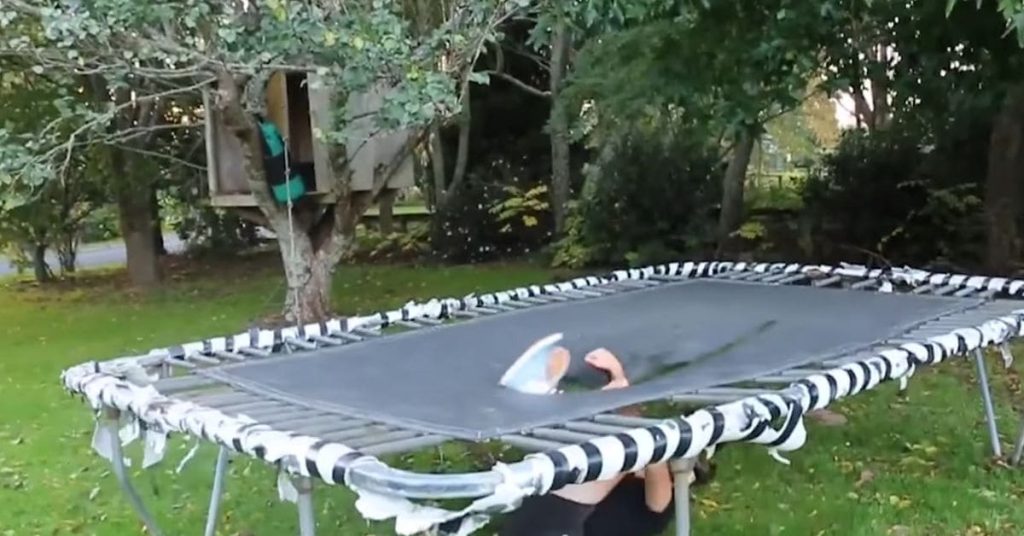
Damage to the frame or jumping surface can also impact a trampoline’s ability to provide a good bounce. Cracks or other damage to the structure can cause the trampoline to feel unstable, while damage to the jumping surface can reduce its ability to provide the necessary tension for a good bounce.
To address this issue, it’s important to regularly inspect your trampoline for any signs of damage and address them promptly. If you notice any cracks or other damage to the frame, you may need to replace those components. If the jumping surface is damaged, you may need to replace the trampoline mat.
Incorrect assembly
Finally, the incorrect assembly can also impact a trampoline’s ability to provide a good bounce. If the trampoline is not assembled properly, it can cause the springs to be unevenly tensioned or the frame to be unstable, which can reduce the amount of bounce.
To address this issue, carefully following the manufacturer’s instructions when assembling your trampoline is important. Take the time to ensure that all components are properly installed, and the springs are evenly tensioned.
Signs of a trampoline that is not bouncy
Trampolines are a great source of outdoor fun and exercise but wear, and tear can cause them to lose their bounce over time. If you notice that your trampoline isn’t providing the same bounce level as it used to, it may be time to look closer.
We’ll explore some common signs of a not-bouncy trampoline and what you can do to address the issue.
Feeling a lack of bounce when jumping
One of the most apparent signs of a trampoline that is not bouncy is a lack of bounce when jumping. You may notice that you can’t jump as high as you used to or that it takes more effort to get the same height level. This can be frustrating and make it difficult to enjoy the trampoline fully.
Sinking or sagging of the mat
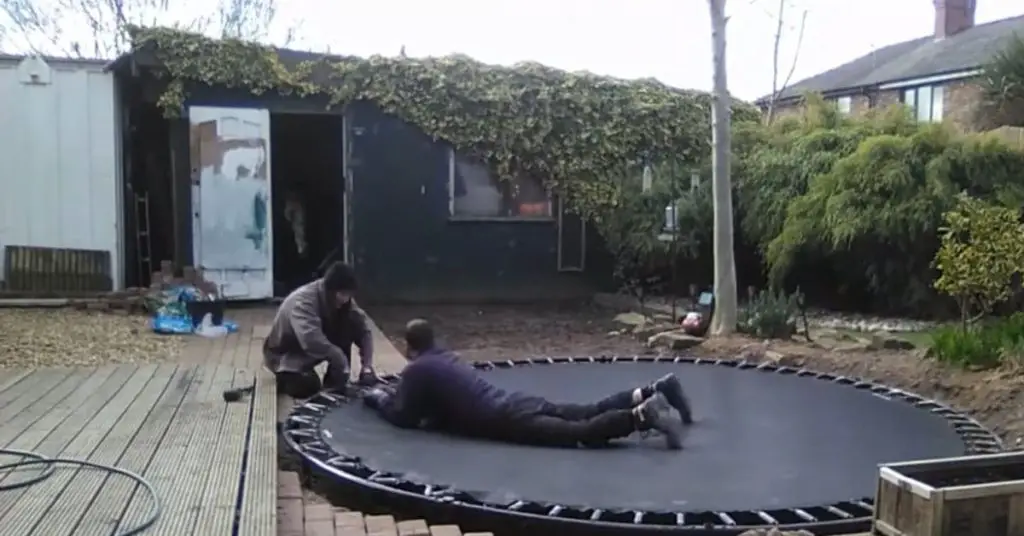
Another sign of a not-bouncy trampoline is the sinking or sagging of the mat. Over time, the carpet can become stretched out or damaged, which can cause it to sink in the middle. This can make it challenging to get a good bounce, as the sagging mat will absorb some of the energy from your jump.
Excessive noise or creaking sounds
If your trampoline is making excessive noise or creaking sounds when you jump on it, this could be a sign that it is not as bouncy as it should be. Some factors, such as worn or damaged springs, loose or damaged frame components, or an uneven jumping surface, can cause this.
The uneven or unstable jumping surface
Finally, an uneven or unstable jumping surface can also be a sign of a trampoline that is not bouncy. Several factors, such as damage to the frame or legs, the uneven ground underneath the trampoline, or a loose or damaged jumping mat, can cause this. A rough surface can make it challenging to get a consistent bounce and increase the risk of injury.
What can you do to address these issues?
If you’re experiencing any of the signs of a trampoline that is not bouncy, there are several steps you can take to address the issue. First, check the tension of the springs and make sure they are properly installed. If the springs are worn or damaged, they may need to be replaced. Also, ensure the frame and legs are secure and in good condition.
If the jumping mat is sagging or damaged, you may need to replace it. Be sure to choose a high-quality rug designed explicitly for your trampoline. If the trampoline makes excessive noise or creaking sounds, try tightening loose components or replacing worn parts.
If you suspect that the uneven or unstable jumping surface is caused by damage to the frame or legs, it may be necessary to replace those components. Additionally, ensure the trampoline is set up on a level surface, and consider using a trampoline anchor kit to secure it.
How to diagnose the issue
If you’ve noticed that your trampoline isn’t as bouncy as it used to be, diagnosing the issue before attempting any repairs is essential. Here are some steps to diagnose the issue with your trampoline.
Inspecting the trampoline for visible signs of damage
The first step in diagnosing the issue with your trampoline is to check the entire trampoline visually. Look for any visible signs of wear, such as cracks or other damage to the frame, tears, or punctures in the mat. These issues can cause the trampoline to lose bounce and create a safety hazard.
Check all of the components of the trampoline, including the springs, frame, and mat, for any signs of wear and tear. Pay attention to any areas that appear worn or damaged, as these may contribute to the issue.
Testing the bounce by jumping on the trampoline and observing the response
Once you have completed the visual inspection, the next step is to test the trampoline’s bounce by jumping on it yourself. Observe how the trampoline responds to your jumping and note any issues you notice, such as a lack of bounce, sagging or sinking of the mat, or excessive noise or creaking sounds.
If you notice any issues, take note of them and consider conducting a more detailed inspection of the trampoline to identify the cause of the problem.
Examining the springs and frame for wear and tear
The springs and frame are two of the most important components of a trampoline, and issues with either of these can cause the trampoline to lose its bounce. Sift through the springs and frame for any signs of wear and tear, such as rust or other damage.
If you notice any issues with the springs, such as broken or damaged springs, consider replacing them with new ones. Similarly, if you see any issues with the frame, such as cracks or other damage, you may need to replace these components as well.
Checking the tension of the springs
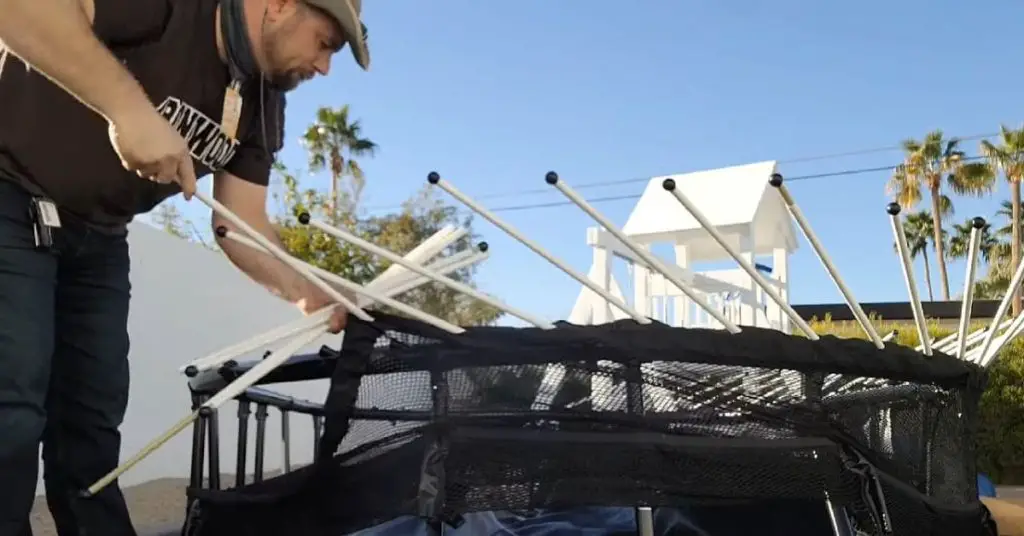
Another potential issue with trampolines that can cause them to lose their bounce is a lack of tension in the springs. To check the pressure of the springs, you’ll need to measure the length of the spring when it’s relaxed and compare it to the size when it’s stretched out.
If the spring has lost tension, you may need to adjust or replace it. Adjusting the pressure of the springs can be tricky, so it’s recommended that you consult the manufacturer’s instructions or a professional before attempting this on your own.
Checking for proper alignment and assembly
Finally, ensuring the trampoline is aligned correctly and assembled is essential. If the trampoline isn’t level or the frame isn’t completed correctly, this can cause the trampoline to lose its bounce.
Check the assembly instructions carefully and make sure that all of the components are in the correct position. If you’re unsure about the assembly process, consult the manufacturer’s instructions or seek the help of a professional.
How to fix the problem
If you’ve identified the issue with your trampoline and have determined that it’s not as bouncy as it should be, there are several steps you can take to fix the problem. Here are some of the most effective solutions for restoring the bounce to your trampoline.
Tightening or replacing springs
Worn or damaged springs are one of the most common causes of a trampoline losing its bounce. You may need to tighten or replace the springs to fix this issue.
To tighten the springs, you’ll need to use a spring puller tool to pull the spring tighter and increase its tension. This can be a complicated process, and it’s important to follow the manufacturer’s instructions carefully to avoid damaging the springs or the trampoline.
If the springs are damaged or worn beyond repair, you must replace them with new ones. Make sure to purchase springs compatible with your trampoline and follow the manufacturer’s instructions for installation.
Replacing the mat with a high-quality one
The mat is another key trampoline component that can affect its bounce. If the carpet is worn or damaged, it can cause the trampoline to lose its bounce and create a safety hazard.
First, remove the damaged mat from the trampoline frame to replace the carpet. Then, purchase a high-quality replacement mat that is compatible with your trampoline.
When installing the new mat, follow the manufacturer’s instructions carefully and ensure it is correctly attached to the frame and springs.
Repairing or replacing damaged parts
If your trampoline has damaged parts, such as a cracked or bent frame, it may need to be repaired or replaced. In some cases, you may be able to fix the damaged parts yourself, while in others, you may need professional assistance.
To repair a damaged frame, you’ll need to use a metal straightening tool to bend the frame back into shape. However, if the damage is severe, you may need to replace the entire structure.
Reassembling the trampoline correctly
If you’ve determined that the issue with your trampoline is due to incorrect assembly, you’ll need to disassemble and reassemble it correctly.
When reassembling the trampoline, follow the manufacturer’s instructions carefully and ensure that all components are in the correct position. Check the tension of the springs and make any necessary adjustments before using the trampoline again.
Maintaining the trampoline
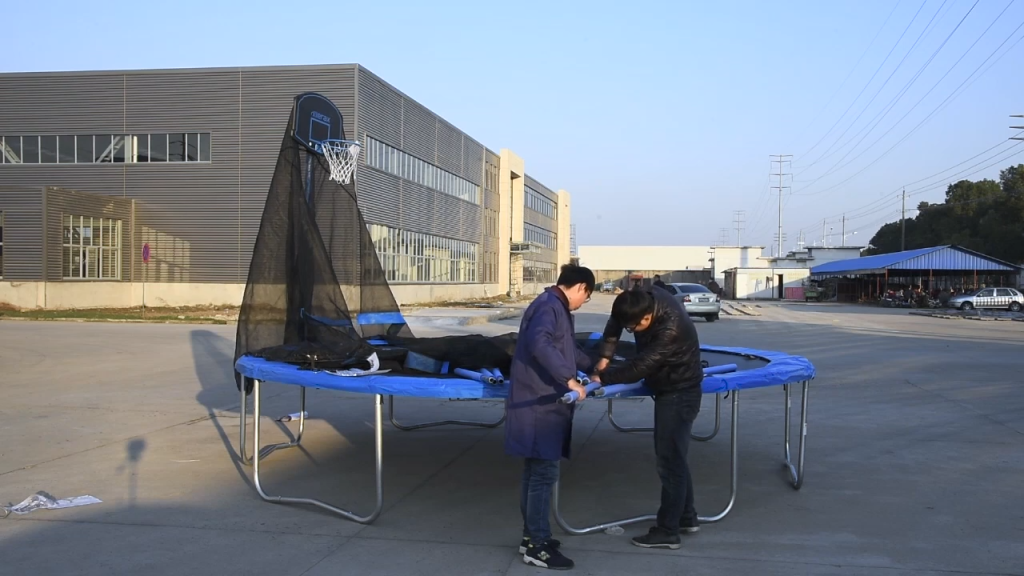
To ensure that your trampoline remains bouncy and safe, it’s essential to maintain it regularly. This includes checking the trampoline for any signs of wear and tear, tightening the springs as necessary, and keeping the mat clean and debris-free.
It’s also essential to follow the manufacturer’s instructions for use, including weight limits and safety guidelines. Avoid using the trampoline in inclement weather, and always supervise children when using it.
Tips for maintaining trampoline bounce
Trampolines are a great way to have fun and exercise, but if the bounce is lacking, it can take away from the experience. To prevent this from happening, it’s essential to maintain your trampoline correctly. Here are some tips for preserving trampoline bounce:
Regularly checking for damage or wear and tear
One of the most important things you can do to maintain the bounce of your trampoline is to check for any damage or wear and tear regularly. This includes inspecting the springs, mat, and frame. If you notice any damage or wear and tear, it’s essential to address it immediately to prevent it from worsening.
Cleaning the trampoline
Keeping your trampoline clean is also essential for maintaining its bounce. Dirt, debris, and other substances can accumulate on the mat and springs, weighing them down and making the trampoline less bouncy.
To clean the trampoline, use a soft brush or broom to sweep off any debris, and then use mild soap and water to clean the mat and springs. Avoid harsh chemicals or abrasive cleaning tools, which can damage the trampoline.
Storing the trampoline properly during off-seasons
If you live in an area where you won’t be using your trampoline during certain times of the year, storing it properly to prevent damage and maintain its bounce is essential. This includes disassembling and storing the trampoline in a dry, cool place. Make sure to clean the trampoline before storing it and to cover it with a tarp or other protective covering to prevent moisture and other elements from damaging it.
In addition to these tips, following the manufacturer’s guidelines for maintaining your trampoline is also a good idea. This may include specific cleaning instructions and recommendations for replacing parts or tightening springs. Taking proper care of your trampoline can ensure that it stays bouncy and provides years of fun and exercise for you and your family.
Safety considerations
When it comes to trampolines, safety should always be a top priority. A trampoline that is not maintained correctly can be dangerous for users and increase the risk of injuries. Here are some safety considerations to keep in mind when maintaining your trampoline:
Importance of maintaining a safe trampoline for users
A trampoline that is not maintained correctly can be a hazard for users, especially children. Users may be more likely to land awkwardly or fall off the trampoline if the bounce is lacking. Additionally, if the springs or frame are damaged, they can pose a risk of cuts or other injuries.
By properly maintaining your trampoline, you can help ensure it remains safe for users and reduce the risk of injuries.
Warning against attempting repairs without proper knowledge or tools
While attempting repairs on your trampoline may be tempting, having the appropriate knowledge and tools to do so safely is important. Attempting repairs without the right tools or expertise can increase the risk of injury or damage to the trampoline.
Instead, it’s recommended to seek a professional’s help or follow the manufacturer’s guidelines for repairs and maintenance.
In addition to these considerations, it’s important to follow other general safety guidelines when using a trampoline. This includes:
- Supervising children at all times when they are using the trampoline
- Limiting the number of users on the trampoline at one time
- Avoiding flips or other risky maneuvers
- Using a safety net or other protective equipment when possible
By following these guidelines and maintaining your trampoline properly, you can help ensure that it remains a fun and safe activity for you and your family.
FAQs
Q.1 How do I maintain the bounce on my trampoline?
Regular maintenance is essential to maintain the bounce of your trampoline. It includes regular cleaning, checking for damage or wear and tear, and proper storage during off-seasons. Additionally, you should ensure that the springs and mat are tightened and correctly assembled.
Q.2 What are the most common causes of a trampoline feeling loose?
The most common causes of a trampoline feeling loose are worn or damaged springs, stretched mat material, or a damaged frame. It can also result from incorrect assembly, improper spring tension, or missing or broken parts.
Q.3 Can I make my trampoline bouncier over time?
You can make your trampoline bouncier over time by replacing worn or damaged parts, including the mat or springs. Proper maintenance and regular cleaning can also help maintain the bounce of your trampoline.
Q.4 How do trampolines work to provide bounce?
Trampolines use the mat’s elasticity and springs to store potential energy when someone jumps on them. As the mat and springs compress, the stored energy is released, propelling the jumper upwards. The greater the tension in the springs, the more bounce the trampoline will have.
Q.5 Are more giant trampolines more or less bouncy than smaller ones?
The size of a trampoline does not necessarily affect its bounciness. It is primarily determined by the tension in the springs and the quality of the mat material. However, more giant trampolines may feel less bouncy due to their size, which requires more force to compress the springs and mat.
Q.6 What exercises can I do to improve my trampoline bounce?
Exercises that can help improve your trampoline bounce include jumping jacks, knee tucks, straight jumps, and various combinations of these jumps. It is essential to warm up and stretch before exercising on the trampoline to prevent injuries.
Q.7 How can I tell if my trampoline needs to be replaced?
Signs that your trampoline needs to be replaced include excessive wear and tear on the frame or mat material, broken or missing parts, and loose or damaged springs. Additionally, it may be time for a replacement if the trampoline feels less bouncy or unstable.
Conclusion
In conclusion, a trampoline may not be bouncy for various reasons, such as lack of tension in the springs or frame, worn or damaged springs, poor quality mat material, structure or jumping surface damage, and incorrect assembly. Signs of a not bouncy trampoline include feeling a lack of bounce when jumping, sinking or sagging of the mat, excessive noise or creaking sounds, and an uneven or unstable jumping surface.
To diagnose the issue, one can inspect the trampoline for visible signs of damage, test the bounce by jumping on it, examine the springs and frame for wear and tear, check the tension of the springs, and ensure proper alignment and assembly.
To fix the problem, one can tighten or replace springs, replace the mat with a high-quality one, repair or replace damaged parts, reassemble the trampoline correctly, and maintain it properly by regularly checking for damage or wear and tear, cleaning it, and storing it properly during off-seasons.
Safety considerations are crucial when using a trampoline, and attempting repairs without proper knowledge or tools can be dangerous.
After reading this easy guide, we hope you understand why your trampoline may not be bouncy. If you have any questions, please ask us in the comments below!

